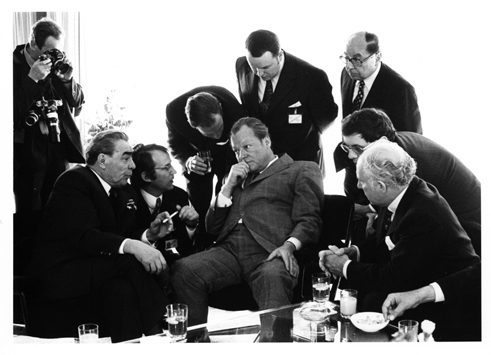Barbara Klemm
Contemporary history through the chronical lens of the camera
She captured Leonid Brezhnev and Erich Honecker locked in a kiss, documented the fall of the Berlin Wall and followed Angela Merkel’s rise to success. Her reportages were always focused on people. Now the work of this photojournalist, that spans a period of almost five decades, is on show in an exhibition in Berlin.
 Leonid Breschnew, Willy Brandt, Bonn, 1973
| © Barbara Klemm
Barbara Klemm captured them all: powerful figures from the world of politics and business, scientists and artists. Working for the Frankfurter Allgemeine Zeitung she accompanied chancellors and candidates, reported on Bundestag debates and party conferences and captured encounters in the international political arena. She was on the spot when the new German Chancellor, Helmut Kohl, shook hands with his predecessor, Helmut Schmidt, after winning the vote of no confidence. And she clicked the shutter to document scenes when the Berlin wall fell in November 1989.
Leonid Breschnew, Willy Brandt, Bonn, 1973
| © Barbara Klemm
Barbara Klemm captured them all: powerful figures from the world of politics and business, scientists and artists. Working for the Frankfurter Allgemeine Zeitung she accompanied chancellors and candidates, reported on Bundestag debates and party conferences and captured encounters in the international political arena. She was on the spot when the new German Chancellor, Helmut Kohl, shook hands with his predecessor, Helmut Schmidt, after winning the vote of no confidence. And she clicked the shutter to document scenes when the Berlin wall fell in November 1989.
Working for the Frankfurter Allgemeine Zeitung
Klemm is rightly celebrated as a chronicler of historical events since the late nineteen sixties. Her images have shaped our awareness and memorisation of significant events and people in a way no other photographer has done.This is due, to a large extent, to the photojournalist’s professional field of work. From 1970 until 2004 Barbara Klemm worked for the Frankfurter Allgemeine Zeitung, a daily newspaper with a circulation of hundreds of thousands of copies. Her photos were published regularly, both in the political and in the travel section, and most importantly in the newspaper’s legendary rotogravure supplement “Bilder und Zeiten” (pictures of our times).
It was these printed versions of her work that made Klemm famous and through which she went on to become an “institution”. These prints are featured in the exhibition that is being held in the Berlin Martin-Gropius-Bau until 09 March 2014. Besides some 320 original copies, showcases also display the corresponding newspaper pages with the printed photos. It is in fact these ─ not the originals ─ that most visitors will remember today.
„B&W provides enough colour”
Original prints and printed copies underscore Klemm’s unmistakable language. She always stuck to black and white analog photography – and still does today. “B&W provides enough colour”, the artist is quoted in the exhibition catalogue. She consistently refused to use flash photography.Klemm’s work does not involve snapshots and it is certainly not candid photography. The images are well composed with a clear structure. The composition is also multiple and complex. “I look for an image that will arouse the observer’s curiosity, one that tells a story, even if this does not coincide with the story written in the article beneath it”, the artist comments, when describing her work.
Barbara Klemm follows her unerring feel for that special, most expressive moment: we can identify this instinct in both her shots of political events and encounters as well as in her travel images or portraits. These shots are taken with a certain detachment. With her composition, however, she builds up a relationship between the persons portrayed to create the impression of an all-decisive moment.
Pictures that tell us a story
This distinct quality is shown, for example, in a picture of Augusto Pinochet in which Klemm captured the dictator’s sceptical look in Santiago de Chile in 1986. Or the picture of Pope John Paul, that shows him amidst cheering crowds during his first visit to Poland.These images, like many others, were shot during her travels. Besides Eastern Europe and South America these trips took Barbara Klemm to China and India, to the USA and to the Middle East. Her focus was constantly on people, not only on the high and mighty but also on the poor: beggars in the slums of Calcutta, black South Africans living under the apartheid regime or Chechen refugees. She documented life in the West Bank, social conflicts in New York and also the negative consequences of gambling addiction in Las Vegas.
In these reportages Klemm always concentrates on the single image and never on a sequence or a series. “I never really liked a series of images that depicts people talking, like in a film”, she comments.
A master of portrait photography
This principle applies in particular to the portrait work Klemm produced over a span of decades; portraits of writers and musicians, artists and scientists. She captured most of them in their typical environment: Botho Strauss in his study, George Tabori in front of the theatre, Josef Beuys engaged in the assembly of his work, or rock legend Mick Jagger performing.The photographer leaves the staging of the scene to the subjects themselves. By doing so, Klemm lets an intimate moment shine through the public image of a prominent figure. Her work has created a “Who’s Who“ of big names from the world of culture and science, one that has yet to be matched in German photography.
“Barbara Klemm 1968-2013”, €48, published by Nimbus Verlag